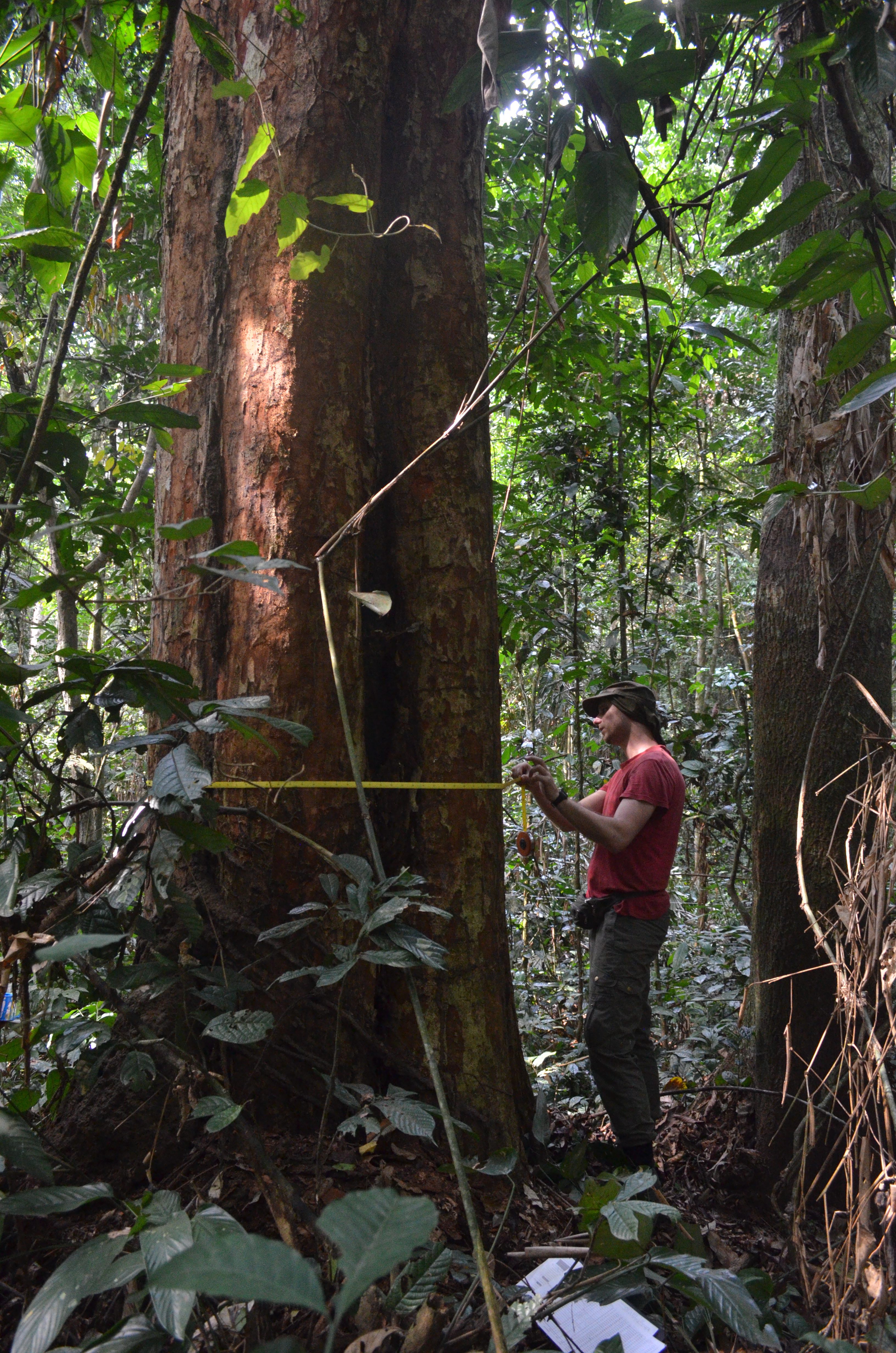
Scientists have determined that trees in the Congo Basin of central Africa are losing their capacity to absorb carbon dioxide, raising alarms about the health of the world's second-largest contiguous rainforest and its ability to store greenhouse gases linked to climate change.
A study published Wednesday in the journal Nature found that some sites in the Congo Basin showed signs of weakened carbon uptake as early as 2010, suggesting that the decline in Africa may have been underway for a decade.
Increasing heat and drought is believed to be stifling the growth of the trees in the African rainforest, a phenomenon previously noted in the Amazon. The new data provides the first large-scale evidence that tropical rainforests around the world that have been untouched by logging or other human activity are losing their potency to fight climate change.
The study predicts that by 2030, the African jungle will absorb 14 percent less carbon dioxide than it did 10 to 15 years ago. By 2035, Amazonian trees won't absorb any carbon dioxide at all, the researchers said.
By the middle of the century, the remaining uncut tropical forests in Africa, the Amazon and Asia will release more carbon dioxide than they take up — the carbon "sink" will have turned into a carbon source.
Tropical forests will "add to the problem of climate change, rather than mitigating against," said Simon Lewis, an ecologist at the University of Leeds in England and one of the paper's co-authors.
The results imply that unless nations accelerate efforts to counter climate change, temperatures will rise even faster than anticipated. The Earth "is more sensitive to carbon dioxide emissions than we thought," said Lewis, who published a less comprehensive study of the African carbon sink in 2009.
The findings contradict models used by the Intergovernmental Panel on Climate Change and governments around the world, which predicted that the Congo Basin rainforest would continue to absorb carbon for many decades to come.
Richard Betts, head of climate impacts research at Britain's Hadley Centre, who was not involved in the new study, called the results "a really important finding."
Scientists have warned for decades that increased temperatures and reduced rainfall could hamper the tropical carbon sink, or the absorption of carbon dioxide by tropical forests.
The researchers estimate that in the 1990s, 17 percent of the carbon dioxide pumped out of smokestacks and tailpipes was taken up by uncut tropical jungles rather than accumulating in the atmosphere, slowing climate change. That figure has dropped to only 6 percent, they say.
The Congo Basin research took more than a decade of work, requiring travel in dugout canoes, on motorcycles and by foot to some of the world's most inaccessible jungles, and the measurement of tens of thousands of trees by hand. "This has been a huge endeavor," said Wannes Hubau, a forest ecologist at the Africa Museum in Brussels and a co-author of the paper.
Tough research environment
The new study's origins date to 2005 when, with a research fellowship from Britain's venerable Royal Society, Lewis began assembling a network of forest plots in Africa that had not been degraded by logging to track the amount of carbon the trees there absorb each year.
A group of several hundred Amazon plots had been set up by a colleague five years earlier. But no one had done a similar survey of trees in the Congo Basin. And Africa is different.
"It's a difficult research environment," Lewis said. The road network in central Africa is spare and poorly maintained, and perennial political upheaval often halts work. Moreover, there's little funding to support such research, and few African researchers with whom to collaborate.
Computing the carbon content of a forest requires boots on the ground, measuring the girth of every tree in a patch about twice the size of a football field as frequently as every few years, Lewis said.
Scientists have come up with standard equations for converting the diameter of a tree trunk into the amount of carbon contained in the wood. The quantity of carbon absorbed, or lost, by a plot is simply the mathematical difference between how much the trees contain in successive censuses.
Lewis set up several dozen sites himself in Cameroon and Congo. But he wanted a record of carbon uptake in the years even before he began. So he sought out plots that had been set up earlier, often for different purposes by other researchers, and often later abandoned.
One study site was started in 1979 in Liberia by a group of German foresters. The researchers fled the country in the late 1980s during Liberia's civil war, and the records there were destroyed. But Lewis ferreted out a database of measurements that had been saved on a computer in the Netherlands. After hostilities ended, he drove to Liberia's only remaining rainforest in 2007 with a sketch of the research locations and found a local resident who had helped conduct the original census. "He led us straight to tree number one of the census," Lewis said. "Now they're a core part of our network."
Expanding the network
In 2013, Lewis hired Hubau to expand the network and look into questionable data on existing sites. It wasn't easy. They wanted patches scattered all across central Africa, as far as possible from human influence.
Hubau reached one site in Congo by motorcycle to find trunks as expansive and true as Greek columns, rising 10 stories above him. He had brought along a sheaf of papers that contained the vitals of each tree with a trunk thicker than his wrist. It amounted to 376 trees, when last counted in 2014.
Hubau noted which trees had died since then and which trees had grown big enough to be added to the roster. He wrapped a tape measure around the trunk of each tree. For trees too broad for Hubau's lanky arms to hug, a helper would pass the dangling end of the tape measure around.
But the site had serious complications. The 2014 crew had nailed numbered tags identifying each tree too tightly to the trunks. Subsequent growth had swallowed up some of them. Termites had attacked red blazes that a 2012 team had painted to mark the height from the ground at which they had applied their tapes. Tree girth must be checked at the same place each time. Even a slight change in the measurement point introduces errors that throw off the carbon tally.
After two days of sweaty labor and detective work, Hubau had identified and measured every tree in that plot.
Predicting the sink's future
The new Nature paper combines the work of researchers and field assistants who studied 135,625 trees at 244 African plots in 11 countries with data that, in some cases, goes back to the 1960s. It concludes that, on average, African trees absorbed the same amount of carbon dioxide for two decades through 2014. But a subset of trees began to lose their capacity to absorb carbon as early as 2010.
A typical acre of African jungle accumulates an extra 1,200 pounds of wood every year, equivalent to about half a cord of firewood. Like their Amazonian counterparts, the African forests appear to benefit from carbon dioxide fertilization — they grow more quickly as the amount of carbon dioxide in the atmosphere steadily increases.
But higher temperatures and increased drought, both detrimental to tree growth, are eroding the benefits of carbon fertilization, according to the new study.
Lewis, Hubau and a long list of colleagues used the African records, combined with a comparable set already available from the Amazon, to tease out the factors that influence the health of the tropical carbon sink and to predict its future.
Researchers have already documented a reduction in carbon uptake in the Amazon rainforest. In a 2015 paper also published in Nature, scientists found that intact Amazon jungle absorbed 30 percent less carbon in the 2000s than in the 1990s. The new study finds that Africa is lagging only 10 or 20 years behind the Amazon. Hubau says central African forests are cooler than those in the Amazon, a factor that has delayed the impact of rising temperatures.
"This carbon sink is turning off far earlier than even the most pessimistic of these climate models," Lewis said.
Now, "we'll have to cut emissions faster than expected," said Betts, of the Hadley Centre.











